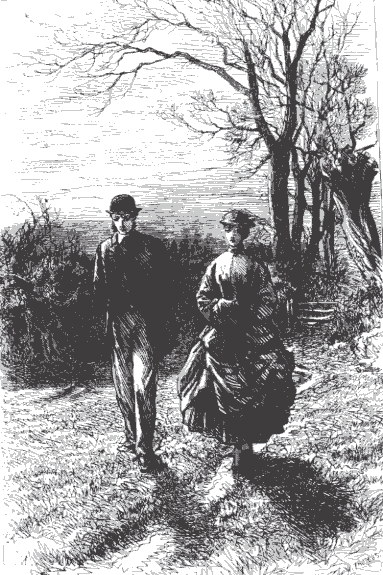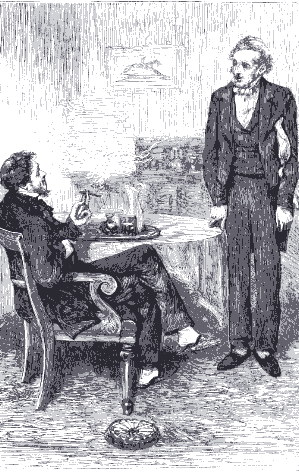The Last Chronicle of Barset
 G. H. Thomas, "Lily wishes that they might swear to be sister and brother", Last Chronicle of Barset
G. H. Thomas, "Lily wishes that they might swear to be sister and brother", Last Chronicle of Barset
It was at the close of June 2000 that our Barsetshire Marathon reached the last of the
Barsetshire cycle, The Last Chronicle of Barset. As this was a very long book our
conversation stretched across the summer and into the first week of October, Indian summer in
Virginia (a beautiful time of year). We had many people posting; at the same time we were
reading Cousin Phillis. This was a good
summer. Once again each week I wrote an essay or essays in the form of postings to Trollope-l
on the chapters we had read for that week. My "facilitating" postings of mine continued to be
close readings of the text whenever I could, with some also simply in response to others, some
on Trollope's sources and attitudes, some on the contemporary scene. Once again the
conversation slowly emerges and moves back and forth on all sorts of things: character, scenes,
personal impulses when we read. Participants included Clarissa Ackroyd, Roger Batt, Maureen Bixley, Catherine Crean, Sigmund Eisner, Judy Geater, Ellen Massey, Howard
Merkin, Rory O'Farrell, Frank Felsenstein; Wayne Gisslen, Paul Goring,
Susan Hankey, Paul Jacob, Kristie Jalicks, Kishor Kale, R. J. Keefe, Mark Jensen, Pat Mahoney, Allen Michie, Susan A. Nash, Rictor Norton, Hugh Osborne, Marian Poller, Michael Powe, Peter Radford,
Teresa Ransom, Angela Richardson, Betty Rizzo; June Siegel, Jill Singer, Jill Spriggs, Francis F.
Steen, Gene Stratton, Tyler Tichelaar, Bruce Toor, Judy Warner, Joan Wall, Jan Wellington,
Dagny Wilson, Andrea Vangor, Amber Vogel, Todd Yelrom. Since people on this and Ms
Thompson's list often talked of The Last Chronicle of Barset, I have included
postings from people who wrote in about the novel well before this particular read. I also
included postings from people on C18-l who answered some of my queries on this book.
I constructed a calendar based on the the first instalment publication of The Last
Chronicle of Barset. It was published between December 1, 1866, and July 6, 1867, in
weekly sixpenny parts and illustrated by George Housman Thomas. The Last Chronicle of
Barset was first published as a book in 1867 (Volume I, March, Volume II, July) by Smith
and Elder. In the first edition what had become the Barsetshire series (1878) Francis Arthur
Fraser was the illustrator. I did what I could to make our calendar reflect the initial serial and first
volumed publication. I also continued my habit of describing the original illustrations to the
Barsetshire novels while we were reading this very last rich one.
Volume I
- June 18: Introduction: Publication, What Trollope Said in His An Autobiography; Translations; Linking
Themes in Barsetshire Series and Religion; Three Critical Essays; Which Novel by Trollope
Have You Reread Most? What is Your Favorite One?; Frequently Reread Books; The Need for
a Community and Fathers; Dorchester and Dorsetshire so Barchester and Barsetshire but the
title is The Last Chronicle of Barset.
- June 25: Chapters 1-6 (Instalments 1 & 2): As We Begin ... ; Griselda again; The Child who was Still Living; The Missing Children; Missing
& Altered Characters; Anthony Trollope's Attitude Towards a Credit Economy; Attitudes Towards
the Clergy; Realistic Assessments of Clergy; Crawley and Griselda; The Adamantine Integrity of
the Rev. Mr. Crawley; Man and Wife; Transparent Plot Devices; Griselda Again; Reading the
books in order and the Crawleys; Griselda/Rosamund Vincy; Griselda Again; Major Grantly and
His Father.
- July 2: Chapters 7-11 (Instalments 3 & 4): The Whole Cast Now On-Stage; Miss Prettyman Defends Crawley; Reappearing Characters;
Credit and Debt; Skating (which on C18-l morphed into Skating as Socialising, Class and Sexual
Activity; Thin Ice; Skating as Socialising, Skating Is for
Everyone); Diet; Reverend Crawley's Dilemma; Checks (Cheques); Banking Practices.
- July 9: Chapters 12-16 (Instalments 5 & 6): Strength and Weaknesses; The Real Star of the Series and this Novel: Barsetshire Society; Not
one But Two Romans-Fleuves!; The Last Chronicle as a Sequel; Johnny
Eames; How old is Lily Dale?; Time scale; Cradell's children; Lily.
- July 16: Chapters 17-22 (Instalments 7 & 8): Encounters; The Unsympathetic Hero; Mr Crawley and the Bishop's Wife, and Robert Louis
Stevenson's A Gossip on Romance.
- July 23: Chapters 23-27 (Instalments 9 & 10): Anticipatory; In Defense of Thomas Hardy; Last Chronicle of Barset: The Cathartic
Experience; The Sentimental; Artistic Episodes in Trollope; The Reappearance of the Lily and
Crosby Plot.
- July 30: Chapters 28-33 (Instalments 11 & 12): The Awkward Foursome; Mr Toogood and the Rev Crawley; Two Somewhat Contradictory
Stories; The Conventional Filler-Nature of the Grace Crawley/Major Grantly Story; More on
Toogood; The Archbishop and His Son.
- August 6: Chapters 34-38 (Instalments 13 & 14): Wimpy Men and Masochistic Women; Shame and Status in The Last Chronicle;
Rev Crawley Crushing the Bishop; Hook Court, Sleazy Money and Near Sex; Idols of the
Marketplace; Grace Crawley on the Marriage Market; Grace and Major Grantly as Uninteresting
Characters; The Crawley Pride; The "Artist" sub-plot in LCB; A Mention of Lady
Glencora Palliser; Trollope and Visual Artists: The Last Chronicle and Ayala's
Angel; Grace Crawley as a Plot Device; Enough of Grace Crawley!
- August 13: Chapters 39-43 (Instalments 15 & 16): Three Lawyers: Vholes, Dockwrath and Toogood: A Comparison of Lawyers in Dickens's
Bleak House and Trollope's Orley Farm and The Last Chronicle of
Barset; Last Chronicle: Reading for Living & Reading for Historical Interest;
Grace Crawley on the marriage market; Grace could do better; Henry Grantly and Grace
Crawley: Numinousness not Money; Anthropological Studies and Grace; Trollope and the Pre-
Raphaelite Brotherhood; Rev. Crawley the Giant; Grace Again and Proud of Her Man's Love; Lily
and Johnnie were lovers?; Velvet Jackets; LCB: A Tempest in a Teacup; Pro-Lily &
Anti-Lily.
Volume II
- August 20: Chapters 44-48 (Instalments 17 & 18): Everyone Has Got Something the Matter with Him of Some Kind; Lily as a Portrait of a Real
Woman.
- August 27: Chapters 49-55 (Instalments 19, 20, 21): Lily as a Portrait of a Real Woman; Mrs Thorne (rich Miss Dunstable that was); Closings;
Obliqueness; Ecclesiastical & Sexual Politics; La Vendée and The Last
Chronicle of Barset: Written by the Same Man; Dalrymple/Van Siever/Madalina, or
Subplot to Hand.
- September 3: Chapters 56-61 (Instalments 22, 23, & 24): The Importance of Paper: Anonymous and Other Kinds of Letters in the stories of Lily and
Johnny Eames and the Rev. Mr. Crawley; Rev. Crawley and Calling Cards; Paper, Greek, and a
Rejection of Modern Society; LCB -- "It's dogged as does it"; Crawley and Lily:
Tragic Figures; Troubled Individuals; Last Chronicle & Public Shame in Trollope; On
Behalf of Dr Tempest; The Ordinary Good Man; Terror at Child Birth and Strong Reluctance to
Become a Baby Machine; Fear of Childbirth in Other 19th Century Novels; " "The End of Jael"
and "Archdeacon Goes to Framley;" On Lily Once Again.
- September 10: Chapters 62-66 (Instalments 25 & 26): The Death of Mrs Proudie: The End of a Story?; Suicide of Dobbs Broughton and Metaphorical
Suicide of Crawley: The End of a Story?; Plans to Do Away with the Bishop?; Josiah Crawley
and Samuel Johnson; The Case of Josiah Crawley.
- September 17: Chapters 67-72 (Instalments 27 & 28): The Novel Draws to a Close; Mystery Solved: We Find Out Who Stole The Check; Mrs Arabin
as dea ex machina; Mr Toogood's Angelic Sherlock Holmes Act.
- September 24: Chapters 73-78 (Instalments 29 & 30): The Crawleys Escape from Total Shipwreck; Characters with Motivational Life Of their Own;
The Characters Explain It to Us; Indications of Popular Culture; The Barsetshire Series as a
Whole; Dr. Thorne is still Barsetshire; Trollope's Repetitions.
- October 1: Chapters 79-84 (Instalments 31 & 3): Trollope's Repetitions; The Oxford and Penguin Introductions to Trollope's Novels; Just what
does Trollope want us to make of John Eames?; The Significance of the Sorry Mr Eames; The
Dyer's Hand and Johnny Eames; The Dyer's Hand and Lily Dale; The Dyer's Hand and Adolphus
Crosbie; Popular Prejudice Against the Barsetshire Chronicles; Mr Eames and Frustrated
Impulses; Fantasy Wish-Fulfillments & Discomforts; How Very Disagreeable a First Plunge May
Be!; Eames's remark about the beating of Madalina; Our Barsetshire group read: What has This
Experience Been Like?; Reactions to the Barsetshire Novels as a Whole; Barsetshire: Septimus
Harding and Josiah Crawley, Key Linking Characters; Mrs. Proudie, An Enjoyable Figure; Johnny
Eames Cuts Out His Initials and Lily's from the Place on the Bridge Where He had Carved them
Earlier & Hearbreak; Lily and Barsetshire; Barsetshire: The Women, Movement Across the
Novels, & Closure; Bunce Comes to Mr Harding's Funeral; Lily and Barsetshire: Parallel and
Echoing Scenes from The Small House and The Last Chronicle; How
are we to take John Eames? Redux; Mr Crawley is Conquered; AT at Home in His World;
Johnny Eames's comment on beating Madalina; John Eames a parallel to Adolphus Crosbie; Lily
Congratulated.
About the Illustrations by George Housman Thomas and Francis Arthur Fraser
 G. H. Thomas, "Mr Toogood and the Old Waiter", The Last Chronicle of
Barset
G. H. Thomas, "Mr Toogood and the Old Waiter", The Last Chronicle of
Barset
Trollope's Apollo
- A Guide to the Classics in the Barsetshire Novels of Anthony Trollope: an informative easy-to-use online guide created by students at Hendrix College and Professor Rebecca Resinski.
Home
Contact Ellen Moody.
Pagemaster: Jim
Moody.
Page Last Updated 17 February 2004


